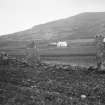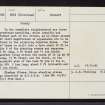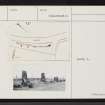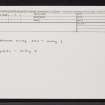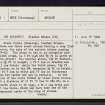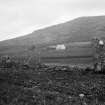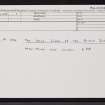Pricing Change
New pricing for orders of material from this site will come into place shortly. Charges for supply of digital images, digitisation on demand, prints and licensing will be altered.
Upcoming Maintenance
Please be advised that this website will undergo scheduled maintenance on the following dates:
Thursday, 9 January: 11:00 AM - 3:00 PM
Thursday, 23 January: 11:00 AM - 3:00 PM
Thursday, 30 January: 11:00 AM - 3:00 PM
During these times, some functionality such as image purchasing may be temporarily unavailable. We apologise for any inconvenience this may cause.
Skye, Borve, Clachan Erisco
Stone Circle (Neolithic) - (Bronze Age)
Site Name Skye, Borve, Clachan Erisco
Classification Stone Circle (Neolithic) - (Bronze Age)
Canmore ID 11269
Site Number NG44NE 1
NGR NG 4519 4801
Datum OSGB36 - NGR
Permalink http://canmore.org.uk/site/11269
- Council Highland
- Parish Snizort
- Former Region Highland
- Former District Skye And Lochalsh
- Former County Inverness-shire
NG44NE 1 4519 4801.
(NG 4519 4801) Clachan Erisco (NR)
OS 6"map, Inverness-shire, 2nd ed., (1904)
Stone Circle (Remains), Clachan Erisco. There are three erect stones forming a very flat curve, the axis of the extreme stones running NW-SE. The stone to the E, an irregular six-sided prism, is 6ft high and 6 1/2ft in girth at the ground; the central stone, 13 3/4ft distant, is 5 1/2ft in height, 3ft 2ins in breadth and 13ins thick; while the third stone, 13 1/2ft further on to the NW, measures 3 1/4ft in height, 2ft 8ins in width and 15ins in thickness; the two latter are set up radially. In the line of the curve formed by these three stones, at a distance of 21ft 10ins to the NW, is a fourth stone 1 1/2ft high, 2ft 4ins broad and 11 ins thick, which may have been one of the component parts of the ring of stones.
In the immediate neighbourhood are three prostrate monoliths, which possibly had formed part of the circle, as no other stones of their magnitutude or appearnace are to be found in the adjoining drystone dykes. One of these is built into a dyke about 20ft to the W of the standing stones and measures 6ft long, 2ft broad and 12ins thick; another lying within two yards of it is 4 1/2ft long, 1 1/2ft broad; and the third, on the opposite side of the road 50 yards to the E, is 5ft 2ins long, about 2ft in breadth and 8ins thick.
(RCAHMS 1928).
Clachan Erisco, three standing stones as described by RCAHMS.
Visited by OS (A S P) 28 April 1961.
Field Visit (21 May 1914)
Stone Circle (remains), Clachan Erisco, Borve.
At the crofting township of Borve, about 3¼ miles north-west of Portree, on the line of the low dyke on the south side of the accommodation road, are the remains of a stone circle called Clachan Erisco. There are three erect stones forming a very flat curve, the axis of the extreme stones running north-west and south-east. The stone to the east, an irregular six-sided prism, is 6 feet high and 6 ½ feet in girth at the ground; the central stone, 13 ¾ feet distant, is 5 ½ feet in height, 3 feet 2 inches in breadth, and 13 inches thick; while the third stone, 13½ feet farther on to the north-west, measures 3 ¼ feet in height, 2 feet 8 inches in width, and 15 inches in thickness; the two latter are set up radially. In the line of the curve formed by these three stones, at a distance of 21 feet 10 inches to the north-west, is a fourth stone 1½ feet high, 2 feet 4 inches broad, and 11 inches thick, which may have been one of the component parts of the ring of stones.
In the immediate neighbourhood are three prostrate monoliths, which possibly had formed part of the circle, as no other stones of their magnitude or appearance are to be found in the adjoining drystone dykes. One of these is built into a dyke about 20 feet to the west of the standing stones and measures 6 feet long, 2 feet broad, and 12 inches thick; another lying within 2 yards of it is 4 ½ feet long, 1½ feet broad; and the third, on the opposite side of the road 50 yards to the east, is 5 feet 2 inches long, 8 inches thick, 1 foot 4 inches broad for the greater part, but widening out to a breadth of 2 feet 4 inches.
RCAHMS 1928, visited 21 May 1914.
OS map: Skye xxiii.














